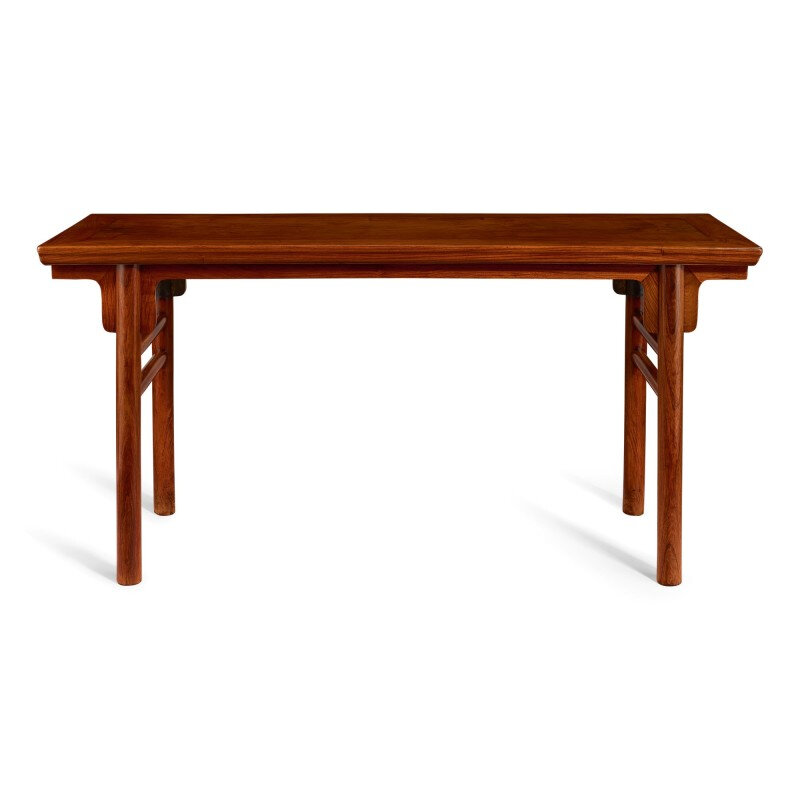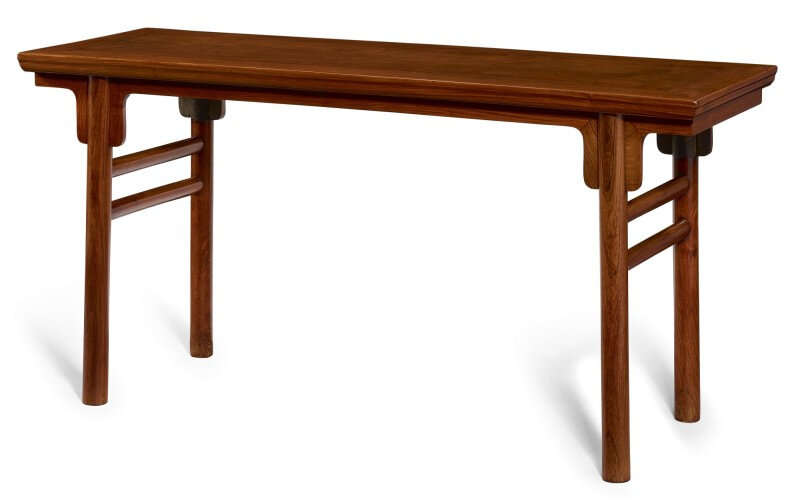the long rectangular top set with a floating panel in a moulded frame, above plain apron with short spandrels, supported on slightly splayed legs of circular section, each pair of legs joined by two horizontal stretchers on the shorter sides.
Note: Fashioned with thick and round members of huanghuali, the present table represents a classic Ming dynasty design, whose popularity has continued to this day. Its top is constructed with a mortise-and-tenon frame with two-board floating panels with beautiful matching grain patterns. Known as 'character one' tables, yi, tables of this form owe their success to their elegant proportions and unadorned surfaces, which draw attention to the wood from which they were fashioned. The form was known from at least the Song dynasty (960-1279) as it is depicted on many scroll paintings of the period.
A table of similar proportions from the collection of Gustav Ecke, is illustrated in George Kates, Chinese Household Furniture, New York, 1948, pl. 30; another from the Haven collection, is published in Dr Chu-Pak Lau, Classical Chinese Huanghuali Furniture, Hong Kong, 2016, pl. 30; and a larger table was included in the Min Chiu Society exhibition The Radiant Ming 1368-1644, Hong Kong Museum of History, Hong Kong, 2015, cat. no. 227.
Illustration in Lienu Zhuan [Biography of Women in Ancient China], Ming dynasty, Wanli period edition, woodblocks carved by Qiu Ying.
Tables of these proportions are often referred to desks or painting tables, as their conspicuous length and depth made them ideal for painting or writing on long pieces of paper or silk. The design was highly popular and reproduced in a variety of sizes as well as on benches and stools.
Sotheby's. Monochrome II, 9 October 2020, Hong Kong

/https%3A%2F%2Fprofilepics.canalblog.com%2Fprofilepics%2F1%2F0%2F100183.jpg)
/https%3A%2F%2Fstorage.canalblog.com%2F03%2F02%2F119589%2F96711876_o.jpg)
/https%3A%2F%2Fstorage.canalblog.com%2F11%2F31%2F119589%2F94773502_o.jpg)
/https%3A%2F%2Fstorage.canalblog.com%2F20%2F83%2F119589%2F94772815_o.jpg)
/https%3A%2F%2Fstorage.canalblog.com%2F26%2F72%2F119589%2F75604929_o.jpg)
/https%3A%2F%2Fstorage.canalblog.com%2F59%2F60%2F119589%2F26458628_o.jpg)





/image%2F1371349%2F20240409%2Fob_fc01a6_2024-nyr-22642-0899-000-a-rare-small-h.jpg)
/image%2F1371349%2F20240409%2Fob_1299ed_2024-nyr-22642-0898-000-a-rare-huanghu.jpg)
/image%2F1371349%2F20240403%2Fob_b08891_telechargement-4.jpg)
/image%2F1371349%2F20240403%2Fob_b24488_telechargement.jpg)